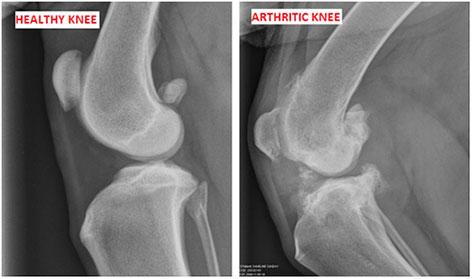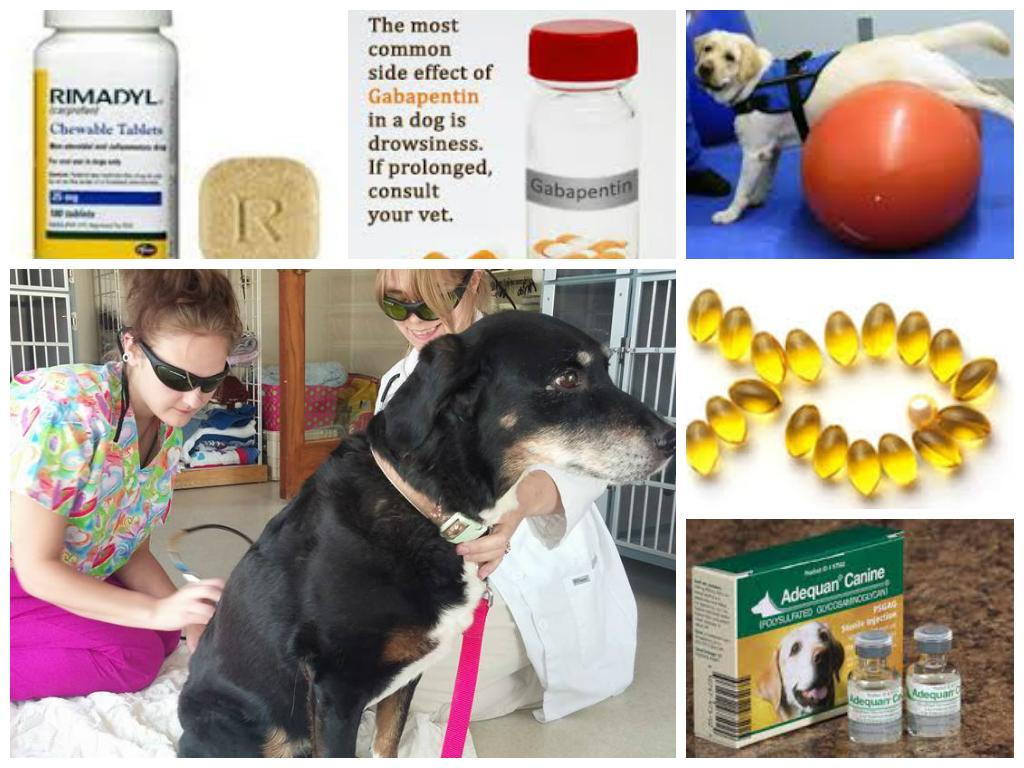- posted: Aug. 29, 2015
Happy Saturday to all! After a review of the cases we have seen recently (especially over the last month), I thought I would put a spotlight on ARTHRITIS.
- What is arthritis?
A wise anatomy professor told me half of being a doctor is knowing Latin. Arthritis is Latin for inflammation (“-itis”) of the joint (arthro). There are many causes of arthritis, including injury and degenerative changes with time. Inflammation in joints triggers changes in the bone that causes irregular proliferation and loss of regular joint space (as you can see in the xray below). 
“He’s just getting older and slowing down” – We hear this quite frequently on our routine annual exam and vaccine appointments in older critters. This could be due to pain from arthritis. Age is not a disease! The changes that come with it are what cause issues in our pets (and ourselves). If your pet is slowing down, we recommend pursuing it – your pet’s golden years should be enjoyed and pain can get in the way.
- Do I need an xray?*
Yes! Although when we do an exam we can detect key features of arthritis (pain, noise and abnormal feel to joints, etc.) – an xray is the way to get a definite diagnosis. This also gives us a way to see how severe the arthritis is and if there are any other changes of concern.
*Before starting laser therapy, an xray is required to rule out cancer conditions.
- What treatment options are there?
There are many treatment options, which are also described in the summary a little further down.I will talk about each from conservative to a more advanced plan, including how they work and side effects.
-Fish oil: Fish oil at HIGH doses has shown benefit for joint health. Lower doses are great for skin and eyes, but we need to go quite a bit higher to help arthritis. The dose for a typical 50 pound dog would be 6-7 capsules a day! Side effects from high dose fish oil include loose stool and gas, so work up slowly. Ask us for your pet’s dose, we’d be happy to work it out for you. As for the type, you can use the same brand you use for yourself.
-Adequan: This is an injectable joint supplement that we have seen good success with. It works similar to fish oil and side effects are minimal.
-Weight management: Maintaining a lean body condition is extremely important in arthritis cases, but also has other health benefits. Just like in people, obesity can make animals prone to things such as heart disease and diabetes. There are many vets that will tell you – “Just feed them less.” But I will tell you the secret right now to know exactly how much.  Your pet’s daily calorie needs are: (Weight in pounds) / 2.2 = weight in kilograms.
Your pet’s daily calorie needs are: (Weight in pounds) / 2.2 = weight in kilograms.
[ (Weight in kgs) x 30 ] + 70 = daily calorie needs.
For example, an 80 lb. dog would need: (80 / 2.2) = (36 kg * 30) + 70 = 1150 kcal/day.
Take a look at your pet’s food label to see how many kcal are in 1 cup to find out how much to feed. If you can’t find the calorie information listed, try this website: petobesityprevention.org , which has a long list of pet food brands and calories. Make sure you account for treats in your daily calculations! And if your pet is already significantly overweight, we recommend cutting the daily need down by about 20%, so multiply the daily need by 0.8
Wow, that’s a lot of math! Feel free to contact us and we can work out a plan for your pet.
Frequent weight check ins are important for monitoring success and adjusting calorie intake (take it from me, a Weight Watchers Lifetime member!). Feel free to bring your pet by any time to get an accurate weight and record it.
Physical therapy: Physical therapy focuses on building muscle strength back to help support the joints. Swimming is an excellent joint-friendly exercise. Acupuncture and laser* can also provide pain relief. As stated above, xrays are required prior to starting laser therapy. Laser therapy works by increasing circulation to an area, which would not be a good thing if there is cancer involved. Our clinic has just added laser to the practice and our patients are loving it!
-NSAIDs: These medications (like Rimadyl or Novox) are excellent for musculosk eletal pain. We recommend blood work prior to starting (and while on) NSAIDs. Just like in people, long-term use of NSAIDs can have effects on the liver and kidney so we want to be sure we aren’t doing more harm than good. If your pet develops any GI signs (vomiting, diarrhea, or black, tarry stool) while on an NSAID, discontinue it and contact your vet. Like people, NSAIDs can result in GI ulcers or worse – a rare but serious side effect to be on the lookout for.
eletal pain. We recommend blood work prior to starting (and while on) NSAIDs. Just like in people, long-term use of NSAIDs can have effects on the liver and kidney so we want to be sure we aren’t doing more harm than good. If your pet develops any GI signs (vomiting, diarrhea, or black, tarry stool) while on an NSAID, discontinue it and contact your vet. Like people, NSAIDs can result in GI ulcers or worse – a rare but serious side effect to be on the lookout for.
-Opioids: Opioids and opioid-like medications (such as Tramadol) can be combined with NSAIDs to help provide relief. Side effects of these medications include sedation and constipation. Tramadol is also a very BITTER pill! Make sure you have something tasty to sneak this into. We also offer Buprenorphine as a transdermal (absorbed through the skin, more Latin!) gel for cats.
-Gabapentin & Methocarbomol: Gabapentin is a medication that is targeted for nerve pain. In advanced cases of arthritis, we usually add this on. Methocarbomol is a very specific pain medication used if there are muscle spasms. We sometimes will add this on in cases of severe back pain with associated spasms. Both of these medications can cause significant sedation.
Every patient is different! We can tailor a plan that works best for your pet and your family.
Below is a good summary for joint health – as recommended by the Orthopedic department at the CSU Veterinary Teaching Hospital.
LIFE LONG JOINT PROTECTION:
1. Attain and maintain a lean body weight.
2. Adopt a lifestyle of regular but MODERATED activity, avoiding intermittent “extremes” of exercise and activities to which she is not conditioned or does not tolerate. We want to keep her active and keep her muscles strong. Swimming is great!
3. Joint protectant supplements such as glucosamine/chondroitin sulfate (Dasuquin/Cosequin) and omega-3 fatty acid supplementation (fish oil caplets). Also, Adequan is an injectable supplement that has been shown to support joint health in dogs.
4. Pain management as needed. We should always keep an eye on her comfort and ensure that we are controlling pain. There is always more we can do to treat pain.
5. Physical therapy as needed. There are a number of certified canine physical therapists that can assess her and develop a strengthening and reconditioning plan to help build up the musculature. They can work with her in their gym and show you exercises to perform at home. This will help restore strength and function which will lead to improved comfort.
And yes, cats get arthritis, too! Many of the same principles apply but cats are very different in the medications they can receive. Always ask before giving your pet anything that has not been specifically prescribed to them.

Well, that is arthritis in a nutshell. A very long blog, but hopefully some useful information. If you have additional questions, always feel free to ask us!



